|
|
|
Sort Order |
|
|
|
Items / Page
|
|
|
|
|
|
|
| Srl | Item |
| 1 |
ID:
128019


|
|
|
| 2 |
ID:
128020
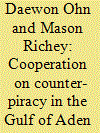

|
|
|
|
|
| Publication |
2014.
|
| Summary/Abstract |
Northeast Asia's regional cooperation is abysmal. Although China, South Korea, and
Japan have generally compartmentalized bilateral trade relations in order to ensure
continuing prosperity of their respective economies, regionally institutionalized
cooperation remains weak, even in this domain. Trilateral political and security
cooperation among these states is virtually nonexistent. China's disinclination (as
an emerging regional hegemon) toward regional cooperation and Japan's failure
to settle its historical problems are regarded as the key reasons for the lack of
such a development. Yet despite this fraught situation the prospects for regional
cooperation among the three main Northeast Asian powers have seen glimmers of
hope. This paper argues that security is surprisingly one of the areas where scholars
and practitioners envision a foundation for increased opportunities for regional
cooperation. The most noteworthy case is the ongoing coordination among
China, Japan, and South Korea (along with some others) to fight piracy in the
Gulf of Aden area. Beyond the result of reducing piracy on commercial shipping,
the counter-piracy effort has fostered cultural exchange among the region's different
navies and coastguards, offering opportunities for growing the spectrum of maritime
security expertise beyond what each country would be able to do alone. This
paper looks at the implications of this combined effort for other potential areas of
cooperation among the Northeast Asian states
|
|
|
|
|
|
|
|
|
|
|
|
|
|
|
|
| 3 |
ID:
128021
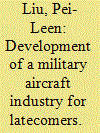

|
|
|
|
|
| Publication |
2014.
|
| Summary/Abstract |
Fighter aircraft development is difficult and high-risk and only few countries have
the ability to develop their own. Taiwan, as a latecomer, has been successful in
the development of a high-performance fighter. This paper illustrates the Taiwan
experience by the method of system dynamics. The results of this study show that
such development by latecomers has the following characteristics: (1) The government
has a strong commitment to the development due to serious external threats; (2) at least
a firstcomer must exist to provide the necessary key technologies; (3) development
requires the long-term accumulation of manpower and technology. This study also
uses the method of the casual feedback loop to interpret and discuss the development
of other latecomers.
|
|
|
|
|
|
|
|
|
|
|
|
|
|
|
|
| 4 |
ID:
128017
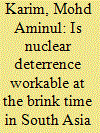

|
|
|
|
|
| Publication |
2014.
|
| Summary/Abstract |
The aim of this paper is to analyze the likely reactions of the nuclear actors, mainly
in South Asia, in any prospective tensed scenario. Nuclear deterrence is generally
being sustained in South Asia since 1971 but a turn of events might suddenly
transform this state to a degree that could prompt the decision-makers to take
hasty and irrational decisions. This paper examines the doctrines, command and
control, safety measures, nuclear terrorism, and above all the strategic stability in
South Asia in order to determine the probability of reaching the brink time. The
paper concludes that even a small-group provocative act may initiate a conventional
showdown to start with, maybe centering on Kashmir or other sensitive issues; it
may then possibly compel the actors to consider the use of nukes.
|
|
|
|
|
|
|
|
|
|
|
|
|
|
|
|
| 5 |
ID:
128016
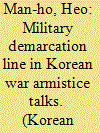

|
|
|
|
|
| Publication |
2014.
|
| Summary/Abstract |
For the Korean War Armistice Talks, as in any war, the establishment of the military
demarcation line was one of the major points of contention between the UN and
Communist forces. Furthermore, the lack of a maritime demarcation line was a
distinct marker in the case of the Korean War. As most international negotiations
do not include detailed information beyond the official transcripts, external indicators
and indirect measures must be considered for a more complete analysis. While
this inferred approach cannot replace a direct systematic study of the negotiation
process, it can still produce some enlightening explanations.
In particular, based on negotiation theory, the current research will focus on the
causes and processes that led to the rejection of the UN forces' request to shift the
land demarcation line further north in return for lifting their naval blockade of the
North Korean sea areas, and the settlement of the maritime demarcation line as it
is today. Thus, the processes, agenda setting, and conclusions of the negotiations
are examined, along with the policy of the United States for ending the Korean
War.
|
|
|
|
|
|
|
|
|
|
|
|
|
|
|
|
| 6 |
ID:
128018
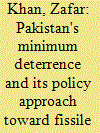

|
|
|
|
|
| Publication |
2014.
|
| Summary/Abstract |
In the immediate aftermath of nuclear weapon tests in May 1998, Pakistan opted
for a policy of minimum deterrence, which entailed that Pakistan would not need
a larger number of nuclear deterrent forces, as a small number of them would be
sufficient to deter. The concept of a minimum deterrence existed even before
Pakistan tested nuclear weapons. However, later Islamabad realized that minimum
could not be sustained as earlier conceptualized. It needed to be evolving and
dynamic. Minimum deterrence (MD) transformed into minimum credible deterrence
(MCD) which had policy implications for Pakistan's force-building structure.
Among its force building, Pakistan not only upgrades its deterrent forces, but also
builds more nuclear reactors which makes Islamabad reluctant to withdraw its
veto from the Fissile Material Cut-off Treaty (FMCT). It requires more fissile
materials in order to enhance its deterrent credibility. Why does Islamabad do
this, and if its policy approach remains consistent with the minimum deterrence it
conceptualized earlier? This article examines the rudimentary factors that increase
Pakistan's security concerns and elaborates on Pakistan's post-1998 shifting policy
approach toward fissile materials in the region's changed strategic environment.
|
|
|
|
|
|
|
|
|
|
|
|
|
|
|
|
| 7 |
ID:
128022


|
|
|
|
|
| Publication |
2014.
|
| Summary/Abstract |
This study aims to analyze security agencies under the National Defense Commission
of the Democratic People's Republic of Korea (DPRK) and suggest its future outlook
under the new leadership of Kim Jong Un. This study found that there are two
major security agencies in North Korea: First, the Guard Command that protects
the surroundings of the Chairman of the National Defense Commission (Kim
Jong Un), and protects North Korean key figures, and state guests; and Second,
Division 6 of the Party Central Committee provides close protection to the Chairman
of the National Defense Commission and his aides and extended family. The Guard
Command is composed of the General Staff Department, the First and Second
Departments, and the General Rear Service Department, and the First Department
is comprised of the Escort Division 1, 2, and 3, the Event Security Division, the
Transportation Protection Division, and the Train Escort Division. Division 6 of the
Party Central Committee has the Operations Section, the Training Section, the Guard
Section, the Event Section, the Rear Service Section, the Mobility Section, and #5
Document Editor. Among which, the Guard Section provides close protection for the
Chairman of the National Defense Commission. In the Kim Jong Un regime, it is
expected that responsibility and authority of Division 6 of the Party Central Committee
will be expanded and that security services will adopt scientification of its skills
and techniques and enhance aerial escort services due to the increasing frequency
of transportation by airplane.
|
|
|
|
|
|
|
|
|
|
|
|
|
|
|
|
| 8 |
ID:
128014
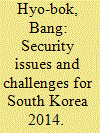

|
|
|
|
|
| Publication |
2014.
|
| Summary/Abstract |
An unprecedented level of complexity arising from simultaneous competition,
cooperation, mutual checks and mutual dependency among nations, marks today's
global security environment. This complex interplay of contradictory patterns of
relations makes it extremely difficult for any single nation, even if it were the
world's superpower, the United States, to determine a course of action proactively.
Despite the geopolitically strategic location it occupies, South Korea is no exception-
a result of the inherent limitations to the makeup of its national strength and the
constant threats it faces from the North. Security and defense are therefore areas
of utmost attention for not only a scholar such as the author, but for all Koreans.
The intention in writing this paper is to delineate the anguish and struggles Koreans
are experiencing in trying to overcome internal and external security challenges,
and also explain their resolve for the future.
|
|
|
|
|
|
|
|
|
|
|
|
|
|
|
|
|
|
|
|
|